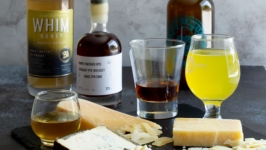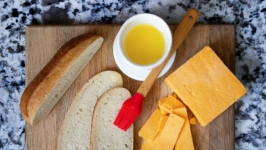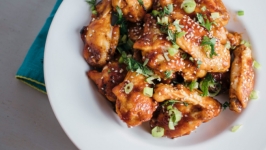Feeding the Jacksonville Jaguars
Having all the skills in the world is only one part of the equation for high-performance athletes who want to excel in the National Football League — eating the right foods can be just as important in competitive sports. Long before kickoff at the stadium, along with practicing passes and going over game strategies, these athletes are following strict meal plans geared toward making them better football players. They require plenty of carbohydrates for energy and enough protein to repair their muscles and recover between workouts. Every athlete has different needs, but they all require fuel, and lots of it.
So, what does it take to feed a football player in the NFL? If you’re Chef Keith Atkins, who oversees ordering and purchasing food in his role as head of performance and team dining for the Jacksonville Jaguars, your weekly shopping list during training camp might look like this: 500 pounds of potatoes, 1000 pounds of chicken, 450 pounds of beef, 200 pounds of onions and enough spinach, pineapple, apples and ginger root to make 70 gallons of fresh pressed juice. Plus, plenty of peanut butter and jelly for sandwiches. “All players stay in hotels during training camp, so we feed them breakfast, lunch and dinner plus snacks every day, seven days a week,” says Atkins.
Now in his third season as culinary director for the Jaguars, Atkins has overseen a big shift in the team’s dining program. In a model that is relatively unique in the NFL, the catering operations feeding the Jacksonville team are owned by the team. And that change has led to an expansion of Atkins’ responsibilities. “My first year we just fed the players, coaches and trainers,” Atkins says. “When we moved over to the Miller Electric Center training facility, we took on more, including the video and other staff. If you work in this building, you eat here.” Altogether that may be 200 people to feed, which translates into a cornucopia of options in the dining hall: pizza, pasta, a grilling station, deli sandwiches, a buffet line, a salad bar, desserts and fresh pressed juices. “Even though we have a count of 200, we’re really cooking food for 300 – the players are all big guys. A player may eat one and one half or two ribeye steaks,” says Atkins.
With his affable personality and over 30 years of experience in the hospitality industry, Atkins is well suited to his role in a demanding and fast-paced environment. After finishing at Penn State, he relocated to Florida but never thought about cooking before moving down here. He ended up taking some culinary classes, then was at Aramark for 20 years as an executive chef, foodservice director and district executive chef. He transferred to campus dining and moved to Flagler College as executive chef for 10 years. In a move that aligned with his love of sports, for the last five years he was a private contract chef for NASCAR, The PGA Tour, the NBA and rodeos. “I catered every sporting event other than baseball. I’m a big sports fan,” says Atkins.
After working with professional athletes over the years, Atkins is aware of how important nutrition has become in meal planning; the type and quantity of food they eat is no longer an afterthought. “In the past, nutrition wasn’t necessarily as critical. Working the different sporting events, I would know the nutritional value, but the athletes didn’t have as much interest. Now, with the Jags, that’s our focus,” says Atkins. That’s why, before any food is ordered or prepared, the first step in his process is to sit down with the Jaguars’ registered dietitians Mindy Black and Jacqueline Trance to map out menus that support the dietary needs, including the daily calorie count, of each player.
Black has been director of performance nutrition for the Jaguars for 10 years. She studied sports nutrition at the University of Florida and worked at a hospital and in private practice before landing her job with the team. “I played sports growing up and being a sports dietitian was in line with what I am interested in. My first job, in a hospital on the cardiac floor, didn’t allow for an in-depth relationship with the patients. I didn’t feel like I was changing anyone’s lives,” says Black. “I’m very health conscious and a competitive person. Working around people who are also competitive and want to be the best version of themselves is really compelling.”
The Jaguars’ management recognized the value and need for two dietitians about five years ago. That’s when Black brought Trance on as an intern and then hired her as associate director of performance nutrition. Trance went to Florida State University because of its football program. “I knew I wanted to work in that industry, but I wasn’t sure how I was going to do that. It wasn’t until I saw that one of the majors was dietetics that a lightbulb went off,” Trance says. “During my sophomore year, I got an internship with the FSU dietitian and worked with their football team for three years.” She started with the Jaguars after obtaining her master’s and dietetic internship from Ohio State.
Menu planning is a collaborative process between the two dietitians and the chef. Black reviews the schedule provided by the coach and notes when practice days will be extra heavy and hot. The players will need plenty of hydration foods and carbohydrates on those days; on recovery days, dietary needs may be different. Armed with that information, Trance and Atkins start to fill in the daily menus. “I’ll finetune the menu selections to make sure ingredients are not too repetitive and that we take into consideration players’ likes and dislikes,” says Black.
Trance looks at the process as a game of Tetris. “We keep in mind food allergies, religious beliefs, what we can’t serve at the same meal,” she says. “Fifty percent of the guys want rice at every meal, fifty percent want potatoes, so we figure out the rotation and different ways to serve the same ingredient. Chicken is our main protein but there’s the percentage who get tired of chicken.”
A big part of the dietitians’ job is education, during training as well as the regular season, to help the players understand more of the science associated with the recommended foods served in the dining hall. “The old school line of thinking was fried chicken, maybe donuts the Saturday before. If you look at science none of that is what you should be eating,” says Black. The dietitians can show the players visually how their food affects their bodies. When they understand that a diet of 75% fat is not the fuel they need for game day, the dietitians are able to help the athletes modify their eating habits. “We’re not going to tell them they can’t have donuts, because that’s a tradition, but we cut down on fried food,” Black says. “We help them incorporate more healthy foods, the fuel they need for performance. Not only have these guys said they feel better, but we can also see a reduction in injuries because they have what they need to go out on the field and do what they need to do.”
The dietitians work with each player to understand what simple carbohydrate they need. And because training camp and much of the regular season takes place during hot weather, almost everything they do considers the need for hydration. Snacks like watermelon, hydration juices and Gatorade slushies are readily available to cool their internal temperature. “Each player has a hydration plan, so when we’re on the field we’re watching each of the guys to make sure they’re doing what their plan calls for,” says Black.
Keeping an eye on calorie count is also essential, as some players may lose up to 20 pounds at practice. “The players may require 3500-7500 calories a day; we know what they need at each meal,” says Trance. “If a player is struggling to keep weight on, we may hover behind them to remind them what to eat as they walk through the food line.” While the 1980s version of the players’ diet consisted of a smorgasbord of food, now it’s more streamlined, with perhaps six ounces of protein, some pasta or potatoes along with some vegetables. “There’s a lot of science behind what we recommend. Even some of the players think, 'oh, she's just telling me to eat a piece of chicken’. It’s our job to monitor how they’re feeling, to keep track of that and figure out what calories are most important, what helps enhance their performance and keeps their weight within a a five-ish pound range for what they need to be on the field,” says Black.
The players come to the dietitians with questions about foods and products they’ve seen in the media or in advertising and want to know more. That’s another opportunity for education. “A lot of times they ask about some popular diet trend that they’ve been hearing about, like a vegan diet,” says Black. “But if I know this player eats zero vegetables and comes to me saying he wants to be on a vegan diet, we need to discuss options, what that would look like realistically and would he be able to commit to that. Maybe we just start with veganism on Mondays and work our way into it.”
While the food may be healthy, it is not bland or tasteless. One day the menu might be filet mignon and chicken cordon bleu; the next day, shrimp jambalaya and ribeye steaks. Atkins orders high quality ingredients such as fresh seafood from C&C Fisheries in Mayport and plenty of seasonal vegetables. The kitchen is gluten-free, and nuts are added on the side of any dish to make it easier for the players to choose what to eat from the deli or pasta stations. All types of cuisine are prepared, including Mexican, Spanish and Italian, as Atkins and his staff try to personalize the dining experience whenever possible and provide the players the feeling that they are being taken care of.
With so much variety and number of meals, Atkins is confident he and his staff can handle the workload. Planning is the key to success. Along with Atkins, the kitchen staff includes 19 employees. “I’ve had this group of kitchen workers for a while, and I know what we can do,” Atkins says. He set up his staff like a football team’s coaching structure. “I’m the head coach and my two sous-chefs are like my offensive coordinator and defensive coordinator. The two supervisors are like the strength and conditioning coach and offensive line coach, and the breakfast cook is my quarterback. She’s here first in the morning and gets things rolling. Everyone has their title, their position so they understand that it’s never going to work if we all don’t come together. I could be the best coach in the world but if I can’t get you to follow the plan, it’s worthless.”
Both dietitians feel that through food, they can make a difference in the players’ lives and performance and help top athletes become even better. “We’ll get texts from players years down the road that something I told them years ago, which was small knowledge to me, changed their lives even off the field,” says Trance. “It’s rewarding when a player comes off the field and tells me, hey what you told me really works, I feel great,” says Black.
While running the dining program for the Jaguars can be a little crazy and crowded, Atkins is not fazed. “I love it, it’s my dream job,” Atkins says. “I’ve worked a lot of sporting events and fed a lot of different professional athletes. It was a lot of traveling and now it’s nice to be home.”

































